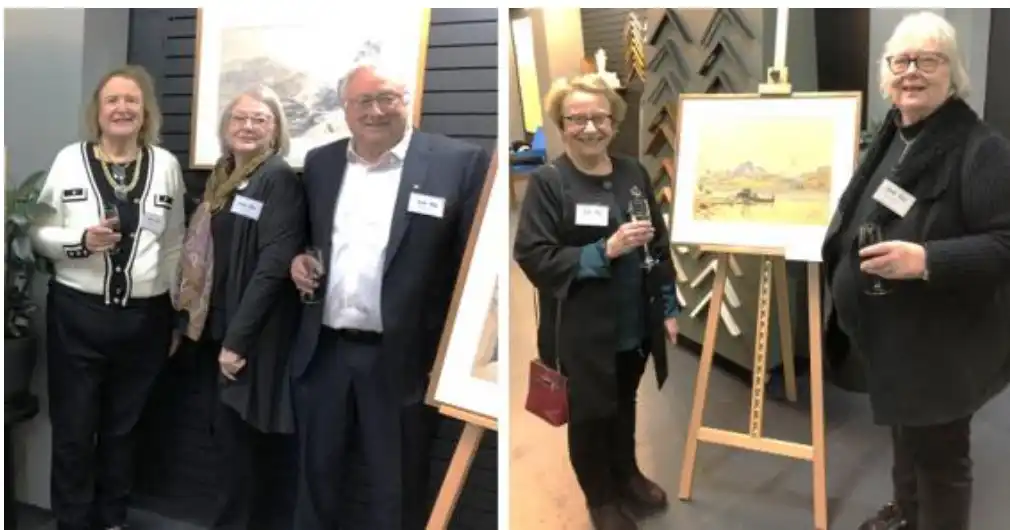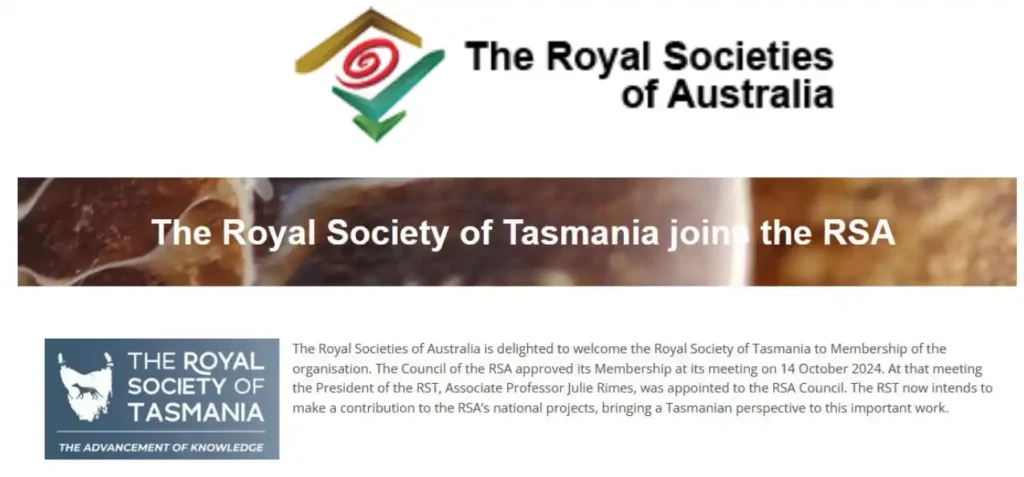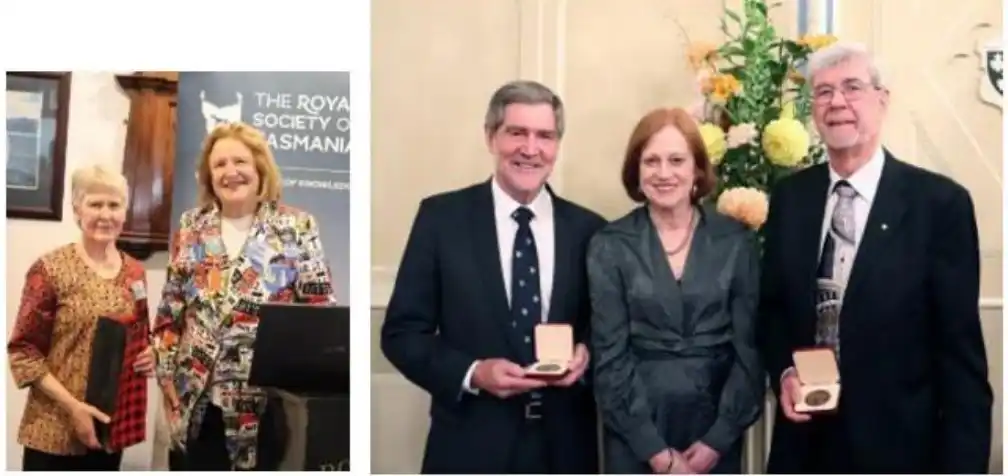
RST Apology to Tasmanian Aboriginal people 2021.

RST Apology to Tasmanian Aboriginal people 2021.
As President, I am profoundly honoured to uphold the legacy of the distinguished line of Council Presidents, members, volunteers, advisers, and scholars who have steadfastly dedicated themselves to ensuring The Royal Society of Tasmania remains well-resourced, pertinent, and ready to shape the prosperous future of our State. The Society’s illustrious heritage, spanning over 180 years, is a testament to perseverance—nearly two centuries of scientific publishing, nurturing talent, and convening expertise to address socioeconomic and environmental challenges through research. In the words of TS Eliot, ‘Only those who will risk going too far can possibly find out how far one can go.’ Our relentless pursuit of resources to advance our mission of advancing knowledge is vital.
Our continued success—including our lecture series in Launceston and Hobart, events, and publications relies heavily upon our persistent and dedicated volunteers, to whom the Society owes an enormous debt of gratitude. This Annual Report details these achievements and acknowledges the occasions and individuals honoured throughout the year.

What have been your Council’s chief preoccupations during 2024? Excellent progress has been made in introducing our historic art collection to art lovers and academics worldwide. For over a year, a group of volunteers, led by Dr Anita Hansen (RST Honorary Art Curator) and Marley Large, have worked diligently to create an online catalogue of our artworks. This web-based system, employed globally by museums, societies, and private collectors, catalogues objects, stores images, manages acquisition information, and publishes collections online. Our collection is accessible here and searchable through Trove. This repository is a work in progress, continuously refined as our research team undertakes further study and responds to user feedback. Officially launched on 3 October 2024, the project is still in its infancy.
Allied to this is the ongoing restoration and conservation of our artworks, accelerated by the Art Fundraising Committee’s efforts, which have raised funds through various projects and successful grant applications. Mary Koolhof, the chief grant writer, deserves our heartfelt thanks. The Art Committee, led by Distinguished Emeritus Professor Ross Large AO, has had a year filled with activity and progress, securing Council approval for the publication of a high-quality, full-colour Art Catalogue, to be published in 2025.
This will be a first-time compendium of all the artworks in our collection, accompanied by scholarly commentary. Additionally, a regional Hidden Treasures Exhibition Series is in preparation, bringing our art to all parts of Tasmania. We gratefully acknowledge the assistance of the Tasmanian Museum and Art Gallery, which houses our collection especially Director Ms Mary Mulcahy who has been supportive of our endeavours, endorsing her staff to provide the necessary assistance.
Our proud and venerable history positions us to remain a relevant source of scholarship and innovation. Early in 2025, we will embark on a new strategic planning process, uniting our collective minds to consider how we might engage the next generation of thinkers and scientists. What do they envision for the future? It is imperative we understand their perspectives and how they perceive our Society. As we know, strategic thinking empowers organisations to anticipate change, unlock potential, and chart a visionary path towards sustainable success and meaningful impact. Our task in 2025 will be to aim high, honouring the past while enabling the future, and to outline a journey that inspires more Tasmanians to understand the Society’s role and importance. This may require presenting The Royal Society of Tasmania to new audiences as a progressive thought leader, building robust, reciprocal relationships beyond academia to embrace corporate and philanthropic engagement. Our immense intellectual capital must be harnessed for the benefit of society and the common good. As former US President, Franklin D Roosevelt, once asserted, ‘the only limit to our realisation of tomorrow will be our doubts of today.’ Though aspirational, this goal is achievable. I urge you to contribute your thoughts and ideas to help shape a bold future.

During the year, the Council agreed for The Royal Society of Tasmania to join the Royal Societies of Australia (RSA). The RSA offers a broad-based national approach to promoting intellectual inquiry in Australia, emphasising evidence-based knowledge beyond science. It promotes the efforts of Australia’s Royal Societies, holds seminars and events on topics of national interest, coordinates activities nationally, and provides a platform for exploring common issues affecting the Societies. It stands distinct from Australia’s learned academies by adopting a broader-based perspective, linking theory, policy, practice, partnerships, and outreach.
As foreshadowed by past President Professor Jocelyn McPhie in last year’s report, the RST Library Collections staff have played a crucial role this year, coordinating a rare book valuation, drafting the Collections Development Policy, and preparing necessary work and discussions to complete our Memorandum of Understanding and Loans Agreement with UTAS. We have also agreed to make the RST Library Collections available through the Biodiversity Heritage Library Australia website. For all this work, I am indebted to Acting University Librarian Caine Chennatt and Cultural Collections Coordinator Katrina Ross.
The Royal Society of Tasmania is governed by the Council, but its work is enacted by Committees. I pay tribute to all the Committees, their members, and the Committee Chairs who drive and guide this work. This dedication is further supported by an even larger group of members who contribute in numerous ways — by organising functions, making donations, attending events, and more. The RST Foundation, led by Chair Neil MacKinnon, has produced a bequest brochure to inspire members to support the Society’s future endeavours. I hope this will encourage you to consider how you can further aid our mission.

We are extremely fortunate to have as our Patron, Her Excellency the Honourable Barbara Baker AC, Governor of Tasmania. Along with Emeritus Professor Don Chalmers AO, the Governor has provided unwavering support, encouragement, and wise counsel throughout the year, for which we are deeply grateful.
As the year ends and January approaches, it is fitting to reflect on Janus, the Roman god of beginnings, gates, transitions, time, and choices. As a Council, we have a full and promising year ahead. I hope you will take this opportunity, as you read the Annual Report, to reflect on our achievements and join us as we strive for even greater success in 2025.

Associate Professor Julie Rimes
President
Annual Report

The Royal Society of Tasmania acknowledges, with deep respect, the traditional owners of this land, and the ongoing custodianship of the Aboriginal people of Tasmania. The Society pays respect to Elders past, present and emerging. We acknowledge that Tasmanian Aboriginal Peoples have survived severe and unjust impacts resulting from invasion and dispossession of their Country. As an institution dedicated to the advancement of knowledge, the Royal Society of Tasmania recognises Aboriginal cultural knowledge and practices and seeks to respect and honour these traditions and the deep understanding they represent.

On 15 February 2021, the Royal Society of Tasmania offered a formal Apology to the Tasmanian Aboriginal people.